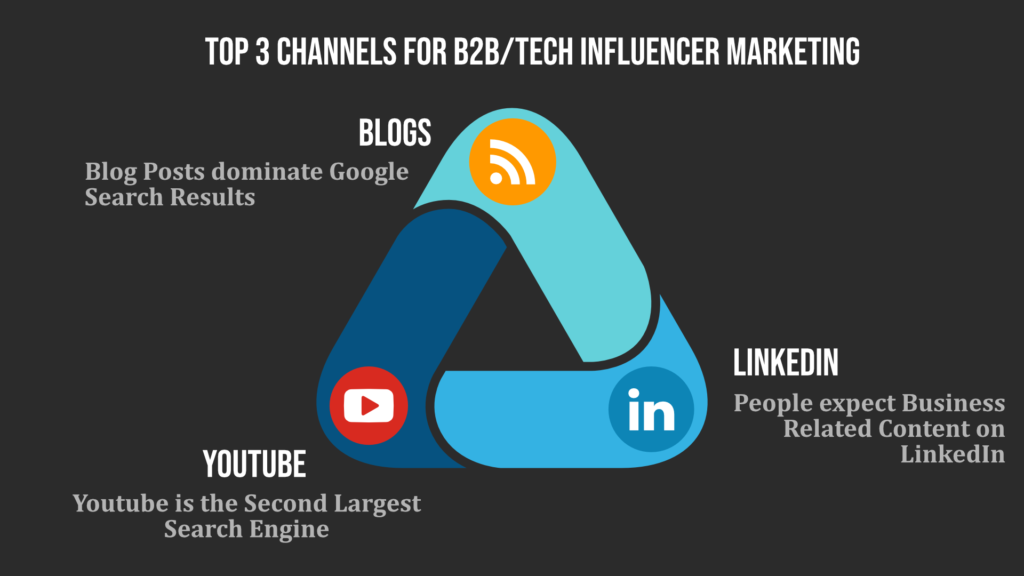Tech & B2B Influencer Marketing: Top 3 Channels [Blogs, LinkedIn & Youtube]
Influencer Marketing is not just for B2C. B2B Influencer Marketing augments PPC & Organic Content Marketing efforts very well. Read on to understand what works in the B2B influencer marketing space.
Which Type of Influencers are Apt for the B2B Segment?
There are three types of influencers: Celebrities, Experts & Peers.
While celebrity endorsement is common in the B2C segment, it doesn’t work as well in the B2B space.
With B2B, it’s generally a combination of experts (for reviews & feedback) and peers (for reach). It’s prudent to create content using a few experts & thought leaders in your industry, and then spread it using a larger number of peer influencers.
Click here to read more about the types & characteristics of influencers.
Identifying and Contacting influencers directly takes a lot of time. Many of them may not want to review/promote your products and services even if you offer them incentives.
That’s why it’s important to work with influencer marketplaces as they already have a database and relationships with influencers who have worked with brands like yours.
Top 3 Channels for Tech & B2B Influencer Marketing

1. Blogs
Blog posts have always, and continue, to be a great resource for research and discovery for vendors, products, and services. After word-of-mouth, Google Search is the second prominent source for the selection of vendors.
One of the main factors that hinder new product adoption is the lack of information. Often, the documentation on product pages is insufficient.
You can engage bloggers to review/write about your products or services as sponsored blog posts. Since they bring a fresh perspective, they would explore the topic from multiple angles that your prospects would find useful.
Blog posts continue to dominate the top organic search result positions. When you get a link from a relevant blog post, search engines and readers would consider it as a vote of confidence.
Blog posts, unlike ads, continue to show up in search engine results for a long time – sometimes for many years after they were published.
Since bloggers are often seen as experts in their domains, you could also use their positive reviews as testimonials in your marketing collateral.
2. LinkedIn
LinkedIn is probably the only social network on which most executives and decision-makers are active. Besides, anonymity is virtually non-existent on LinkedIn – these are real people with real positions.
People on LinkedIn are actively looking to consume business-related content. Contrast that with the intent of people on Facebook or Instagram.
The LinkedIn algorithm, at least currently, seems to favor organic reach of posts shared by its users, over ads. Certain factors like using the right hashtags, tagging the right people, and using native video, etc. can skyrocket your reach.
Since it is possible to create and share content in multiple formats including text, images, PDF, and videos, it is easier to engage people with some creativity. The right LinkedIn Influencers help creatively communicate your value and vision.
A simple search in the LinkedIn search bar would show you the influencers and their engagement levels for the posts containing keywords related to your niche.
You could also join related LinkedIn groups and identify the active influencers over there. Or you could use LinkedIn’s paid tools to gather even more info about your prospective influencers and their connections.
3. Youtube
Youtube is the #1 Platform for Tutorials, Comparisons, Unboxing & Experiential content. Youtube is also the second-largest search engine after Google for vendor and product discovery.
If these are not good enough reasons to use Youtube Influencers to promote your product, consider this: Youtube’s Influencers are some of the most creative storytellers. Hence it’s better to allow them to create content in their style.
When your prospects are engaged and emotionally hooked to your brand, diverting them to your site and converting them into customers becomes easier.
Youtube is an excellent platform for your top executives to share their knowledge and establish their personal brands as thought leaders in your niche. Imagine how much that can humanize your brand and appeal to your prospects.
Youtube videos created by influencers get viewed continuously over the long-term, like blogs. You could link your product pages at the end of videos or in the description and measure parameters like clicks, but people also tend to recollect and directly reach your website through a web search, etc. later on too.
Things like giveaways, contests, coupon codes, and exclusive content work like a charm on Youtube as well. You could tease new products to create hype and launch them on Youtube Live to engage fans spread across the world.
Influencer Marketplaces enable you to identify the influencers in your niche and choose the best ones to work with. They provide at-a-glance information about influencers like their total reach, follower count in each channel, engagement levels, cost-per-engagement, expertise, traffic, etc.
Here is the story of a B2B influencer who has successfully navigated brand partnerships through a top influencer marketplace.
You can also leverage B2B influencer marketing by organizing events or by speaking at tech/marketing events organized by others as many influencers and a few prospective customers may be among the audience.
For example, have a look at the Digital Innovation Virtual Conference 2020 scheduled for Nov. 5, 2020, where experts cover trending topics on Artificial Intelligence/Machine Learning, Internet of Things, Cybersecurity, Augmented Reality/Virtual Reality & Enterprise Analytics – among others.
If you are not using influencer marketing to promote your Tech/B2B products and services yet, it’s high-time you do. If you have already tried, let us know your experience in the comments.